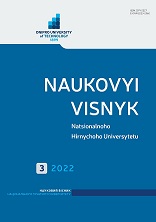

 | Наукова періодика України | 
| Naukovyi visnyk Natsionalnoho Hirnychoho Universytetu |
Fateyev A. I. The energy technological background of involving salty coals into energy balance of Ukraine. 1. Composition of water extracts and the prospects for their utilization / A. I. Fateyev, T. G. Shendrik, S. S. Polishchuk, N. I. Dunayevska // Науковий вісник Національного гірничого університету. - 2018. - № 6. - С. 40-47. - Режим доступу: http://nbuv.gov.ua/UJRN/Nvngu_2018_6_8 Coal with high content of alkaline and alkaline earth metals (salty coal (SC)) occupies its definite place in an energy reserve of Ukraine. Deposits of SC are located in central industrial regions, the coal has high fuel indexes and can soon definitely get its share in blended fuels which will meet the standards of Ukraine and will be qualified for use at modern Thermal power plant (TPPs). In order to determine the rational ways of involving salty coal in the burning processes, the world practices widely use the detailed studies of the impact of natural mineral substances on the processes of slagging, sticking and corrosion in case of the burning of such coal. Purpose. To determine the composition of natural water-soluble minerals in coal which cause a number of burning problems using non-destructive methods, a comparative analysis of the composition of mineral phases in SC from various deposits in Ukraine, to assess their slagging ability, and overview the prospects of utilizing flushing water generated during coal desalting. Methodology. Applying the technological regimes of desalting developed by the authors, water extracts of SC have been obtained, which are investigated using a non-destructive X-ray diffraction method of dry substances (device DRON 4M), the composition of mineral phases of SC extracts is studied with the MATCH! program. Total content of salts and their removal efficiency are estimated using the 4805 Conductivity TDS/Temp indicator/EZODO. Findings. The composition and peculiarities of the mineral phases from extracts of salty coals of different domestic deposits are determined. The fouling factor of SCs of different deposits in Ukraine was calculated from the chemical composition of ash; a comparison was made with the data of world sources. It is shown that even with a close value of the sodium oxide content in the ashes, salty coals of different deposits differ significantly regarding the assortment (from 2 to 5 varieties are found) of native water-soluble minerals and their ratio. It is shown that in aqueous extracts from two samples of salty coals it is the sulfate is the prevailing mineral, not halite. Originality. For the first time, a comparative semi-quantitative analysis of the native mineral phases in dry water extracts of SC from three Ukrainian deposits was performed; data on the conditions for efficient coal desalting was summarized. The contamination factor for SC from various deposits in Ukraine is determined, comparison with world sources data is performed. Prospects for disposal (storage) of flushing waters generated during salty coal preparation for energy use are considered. Practical value. The detailed study of dry water extracts and obtained composition of mineral phases allowed predicting: 1) the formation of low fusible eutectics in the process of burning of domestic salt coals and the determination of special process conditions that prevent slagging; 2) the behavior of mixed fuels of SCs with coals marked with significant presence of refractory compounds; 3) the choice of such mineral impurities including industrial wastes that reduce the risk of slagging and corrosion when burning domestic salty coals.Salt coal (SC) of the Northern Donbas in the list of non-project fuels is a perspective source of energy in Ukraine under the conditions of occurrence and reserves. This is due to its relatively high energy (fuel) characteristics and the presence in its composition of the natural catalytic complex - the increased content of salts of alkali and alkaline earth metals and trace elements. These impurities, on the one hand, can lead to some burning problems, but can also have a positive effect when such coal in mixtures with other less reactional fuels is used. Purpose. Determination of the influence of water-soluble compounds (chlorides and sulphates of sodium, calcium, magnesium, etc.) on the thermolysis (combustion) processes of salt coal of Bohdanivsk deposit (the Northern Donbas) at different temperatures. Methodology. Samples of desalted coal were obtained using previously optimized parameters of the process aqueous extraction (time, temperature, and solid to liquid phase ratio). The elemental composition and technical characteristics of coal are determined by appropriate standard methods. The dynamics of gas emission and combustion of coke residues of salty and desalted coal was determined using the "Pyrolysis M" installation. The MX-1215 mass spectrometer was used as a gas analyzer. The kinetic parameters of the process were calculated based on the Arrhenius law. Findings. The changes in the elemental composition of the organic mass of coal (OMC) occurring during the purification of salty coal by water extraction are determined. Experimental studies have been conducted on the combustion of salty and desalted coal of the Bohdanivsk deposit in the temperature range of 550 - 850 <^>o Цитованість авторів публікації: Бібліографічний опис для цитування: Fateyev A. I. The energy technological background of involving salty coals into energy balance of Ukraine. 1. Composition of water extracts and the prospects for their utilization / A. I. Fateyev, T. G. Shendrik, S. S. Polishchuk, N. I. Dunayevska // Науковий вісник Національного гірничого університету. - 2018. - № 6. - С. 40-47. - Режим доступу: http://nbuv.gov.ua/UJRN/Nvngu_2018_6_8. |
|
|
Всі права захищені © Національна бібліотека України імені В. І. Вернадського |
|||||